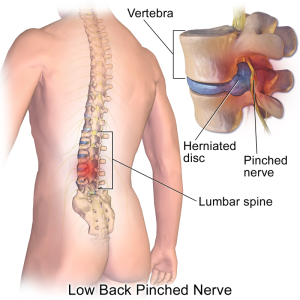[retweet][facebook]
Acupuncture and electroacupuncture relieve lower back pain due to disc herniations. Heilongjiang University of TCM researchers investigated the analgesic effects of both manual acupuncture and electroacupuncture. Both types of acupuncture successfully relieved focal lower back pain and sciatica.
 Electroacupuncture outperformed manual acupuncture in achieving the greatest number of positive patient outcomes. The total effective rate for the relief of pain was 97.5% for electroacupuncture and 89.5% for manual acupuncture in the randomized controlled trial. The total effective rate included patients with significant reductions or elimination of pain, improved lower limb reflexes, ability to resume work, and significant improvements in range of motion.
Electroacupuncture outperformed manual acupuncture in achieving the greatest number of positive patient outcomes. The total effective rate for the relief of pain was 97.5% for electroacupuncture and 89.5% for manual acupuncture in the randomized controlled trial. The total effective rate included patients with significant reductions or elimination of pain, improved lower limb reflexes, ability to resume work, and significant improvements in range of motion.
The researchers applied acupuncture to the following acupoints:
- BL31, Shangliao
- BL32, Ciliao
- BL33, Zhongliao
- BL34, Xialiao
- BL54, Zhibian
- BL40, Weizhong
- BL60, Kunlun
A manual acupuncture group was compared with an electroacupuncture group whose BL31, BL40, BL34, and BL60 acupoints were stimulated with continuous wave stimulation at a comfortable intensity level. Electroacupuncture was only added after the arrival of deqi at the acupoints. Total needle retention time was 30 minutes per acupuncture session for both groups. All patients received acupuncture at a rate of once per day for ten days. The researchers concluded that both acupuncture and electroacupuncture are safe and effective for the treatment of lumbar disc herniation pain.
The researchers conducted a protocolized study using a predetermined acupuncture point prescription for all participants in the investigation. No customization of the acupuncture point prescription was made based on individual symptoms or differential diagnostics. This approach differs from standard clinical usage wherein a licensed acupuncturist customizes the treatment protocol based upon signs and symptoms. The predetermined acupuncture point prescription is common in research due to the efforts of investigators attempting to eliminate experimental variables.
The researchers note that one part of the investigation was to test the efficacy of needling the Bladder Foot-Taiyang acupuncture meridian for the treatment of lumbar pain. Citing a historical precedent in Traditional Chinese Medicine (TCM) principles and usage, the researchers applied a modern biomedical experiment to test the ancient indication for use of Bladder Foot-Taiyang acupoints for the treatment of lower back pain. Based on the findings of the investigation, the researchers conclude that needling Bladder Foot-Taiyang acupuncture points are effective in the relief of lumbar disc herniation related pain. Moreover, the researchers conclude that the addition of electroacupuncture is more effective than using only manual acupuncture.
This investigation tests manual acupuncture, electroacupuncture, and TCM theory on the effectiveness of Bladder Tai-Yang meridian usage for lower back pain treatment. Using a modern randomized controlled study, investigators tested the principle of treating pain along the course of a meridian’s pathway with acupoints located on the meridian. In addition, TCM principles state that lower back pain may be treated with the application of Bladder Tai-Yang meridian points. The results confirm this ancient principle making this an intriguing study in that both clinical results and ancient TCM theory align in a modern investigation.
Excerpt from:
